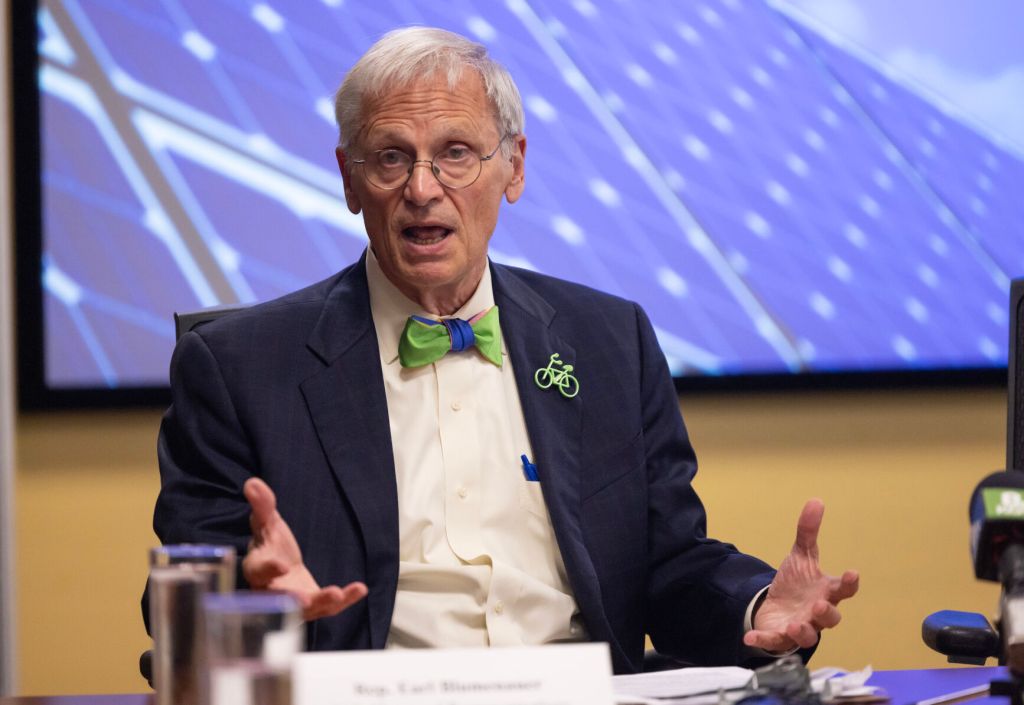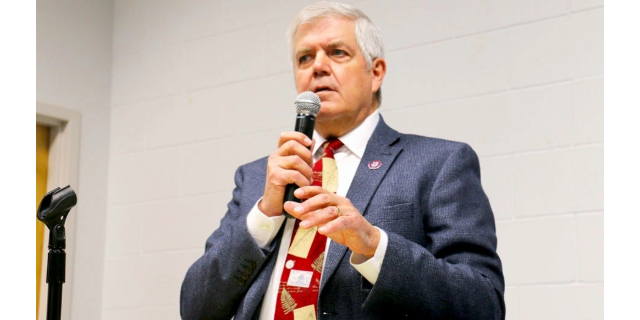Blumenauer ends record tenure in elected office, but not public life
Published 12:32 pm Wednesday, November 15, 2023

- Rep. Earl Blumenauer.
Earl Blumenauer may be ending his decades in elected office — at 52 years, likely a modern record for Oregon — but he’s not ready to leave public life.
With barely a year to go before he ends 28 years representing Oregon’s 3rd District in the U.S. House, the veteran Democrat from Portland spoke at length about how the city, the metro area and the state can benefit from recent federal legislation and other actions that he helped shape. He plans to continue doing it, though no longer in Congress or any other public office, and to encourage others to take on some of the causes and programs he has championed over the years.
“There are a lot of moving pieces here that are part of a legacy I have developed,” he said from his Capitol Hill office. “I want to make sure it is handled right.”
“These are things that in some cases I’ve been working on for decades,” he added. “We now have this huge sum of money freed up because of our work over the past couple of years. I’ve been spending time advising people how to access that money.”
He referred to two recent federal laws and a more flexible Medicaid policy under an Oregon waiver that have made available billions for communities to upgrade public works beyond highways and bridges, adapt to climate change and speed a transition to carbon-free energy, and provide food and housing in addition to medical care for personal health.
After working as a college student to lower Oregon’s voting age from 21 to 18, Blumenauer was elected to the Oregon House at age 24 from Southeast Portland.
Then he was elected Multnomah County commissioner (1978-86) and Portland city commissioner (1986-96) before he won the congressional seat that Ron Wyden vacated for the U.S. Senate earlier in 1996. He also served on the Portland Community College board.
He is not Oregon’s longest-serving House member. That record goes to Peter DeFazio of Springfield, who retired in 2022 after 36 years. He has been in elected office longer than Mark Hatfield, a Republican who spent a combined 46 years in both chambers of the Oregon Legislature, secretary of state, governor — and U.S. senator.
The 3rd District now takes in about two-thirds of Multnomah County — Portland west of the Willamette River, and a little bit eastward, is in the 1st — plus Hood River County and part of Clackamas County. Blumenauer won his most recent race in 2022 with 70% voter support, and has never drawn less than 67%. His successor is likely the winner of the Democratic primary on May 21.
Federal action at last
Blumenauer sat for two decades on the House Ways and Means Committee, which originates tax and trade legislation and health care financing. Behind the scenes, he shaped many of the provisions of what became the Infrastructure Investment and Jobs Act in 2021, and the Inflation Reduction Act in 2022.
Though half of the $1.2 trillion that Congress approved in 2021 simply renewed federal spending on highways and bridges, a total of $550 billion went into other transportation programs, such as bicycle lanes and pedestrian paths, public transit, passenger and freight rail, ports, traffic safety, charging stations for electric vehicles. Blumenauer has been an advocate for bicycles — his trademark, aside from bow ties, is a bicycle-shaped pin — and he says even Washington, D.C., has become more bike-friendly in the years he has been in Congress.
The law also provides money for expanded broadband access and improvements to the power grid and water systems. There’s even $1 billion that Blumenauer secured for projects that reconnect communities — many of them populated by people of color — that were split by the construction of the original interstate highway system in the 1950s and 1960s.
Blumenauer said that the legislation built on a law passed 30 years earlier that designated development of specific corridors for highways and rail. In Oregon, they were Interstates 5 and 205 and part of U.S. 395 in Eastern Oregon, plus the Northwest rail corridor from Eugene to Vancouver, Canada.
“What we have done in this legislation is to broaden its scope,” he said. “It is not unprecedented, but this is more complex and there is more money involved. This administration wants this money invested in ways that promote a low-carbon future and equity. It is an opportunity to do more — and do more with public support.”
Aside from a replacement for the Interstate Bridge that connects Portland with Vancouver, Wash., Blumenauer said Oregon could tap that money for a bus rapid transit line on 82nd Avenue — Route 72 has the highest ridership in the TriMet system — and safety and other improvements on “orphan highways” such as 82nd Avenue and Tualatin Valley Highway. Such highways once carried traffic between cities, but because of development patterns, are now urban arterials not designed for city traffic.
Division Street in Portland and Gresham has a bus rapid transit line, which provides for more frequent bus service and fewer traffic impediments to it.
Blumenauer said 82nd Avenue, six miles of which the Oregon Department of Transportation transferred to Portland in 2022, could be made a lot safer — and there would be a bonus.
“This has the potential of unlocking investment for hundreds of housing units up and down that corridor,” he said.
“We have a challenge in affordable housing. But this is an area with lots of sites where the neighborhood would welcome redevelopment. I am hoping that people will focus on that, as well as Tualatin Valley Highway, and get some additional state and federal money — plus what local governments come up with — to be able to capitalize on an opportunity to improve safety and add to housing.
“These projects do not take 20 years and cost billions of dollars,” he added. “These are things that can make a difference in the next couple of years — and they are a few million dollars, still a big number.”
Blumenauer said among other sites with redevelopment potential are the Lloyd Center mall and Montgomery Park in Northwest Portland.
Climate change and restaurant aid
Blumenauer also hopes that Oregon can capture some of the $370 billion available over the next decade under the Inflation Reduction Act for projects to adapt to climate change and transition from carbon fuels (oil, gas and coal) to alternative energy sources. The 2023 Legislature approved $90 million, which officials hope to secure up to $1 billion for such work.
“This is the largest investment in clean energy anywhere in the world,” he said. “We have a chance to try to take advantage of it for programs here in Oregon.”
Blumenauer has called on President Biden to declare a climate emergency, which Blumenauer said would make it easier to shift money. Biden has not done so; he spent much of his first two years as president coping with the coronavirus pandemic and the resulting economic downturn in 2020.
“Dealing with those challenges … made it hard to concentrate on some of these opportunities,” he said. “But it is every bit as urgent, and growing more so every year. The evidence is that we are facing more extreme weather events. We have opportunities to capture this federal money to help us cope with these challenges.”
The American Rescue Plan Act, Biden’s $1.9 trillion package that passed Congress in early 2021, contained $28.6 billion for aid to independent restaurants. It was an idea advocated by Blumenauer, though he credits local restaurateurs with developing it. It was far short of the $120 billion requested, but Blumenauer said it helped 100,000 restaurants, including many in Oregon.
“But one of the things that happened in putting together this proposal was that in mobilizing political support for it, we worked with what has developed into the Independent Restaurant Coalition,” he said. “They helped us get this passed. But they are also interested in what is necessary for independent restaurants to thrive.”
From beginnings to the end
Blumenauer was an advocate for the 18-year-old vote, which the Oregon Legislature passed in 1971 just before a U.S. constitutional amendment set 18 as the national standard. At age 24, he was elected to the Oregon House, one of the youngest ever to serve.
“I was challenged with some local problems that led me to throw my hat in the ring and represent a district in Southeast Portland,” he said.
He was one of 27 new representatives elected after Oregon went to single-member districts in 1972 — only term limits then in effect in 1999 and 2001 produced comparable numbers — and the 1973 Legislature is still regarded as a landmark session in Oregon history. Among its achievements: Statewide land use planning, a state transportation commission, open meetings and public records laws, the first government ethics and campaign finance laws — though a spending limit was overturned in 1975 — and a violation and a maximum $100 fine for possession of one ounce or less of marijuana, instead of criminal penalties. (Blumenauer is known in Congress for his advocacy of federal marijuana-law reform.)
Later, while still in the Legislature, Blumenauer opposed the proposed the Mount Hood Freeway that would have gone through Southeast Portland — and then-Mayor Neil Goldschmidt and Gov. Bob Straub supported what eventually became the region’s first light-rail line connecting Portland with Gresham.
“It was an amazing time to be involved. So there was an air of possibility,” Blumenauer said. “The three legislative sessions I was privileged to be a part of and helped lead were transformational for me. It led me on a path that continues to this day.”
But he also said he believed in making the system work, not tearing it down.
“I would like to think we were not rebels so much as being change agents,” he said. “My record is one of bringing people together to try to solve problems. That is why we had success. If you concentrate on the things that divide people, you are never going to get anything done.”
Position: U.S. representative, 3rd District, May 1996 through Jan. 3, 2025. Current committees: Budget; Ways and Means.
Age: 75.
Education: Centennial High School, Gresham, 1966; Lewis & Clark College, bachelor’s degree, 1970, law degree, 1976.
Family: Wife, Margaret Kirkpatrick; two children.
Public office: Oregon House, 1973-78; Multnomah County commissioner, 1978-86; Portland city commissioner, 1986-96. Also Portland Community College board, 1975-81.
Other: Assistant to president, Portland State University, 1971-77; candidate for Portland mayor, 1992.





